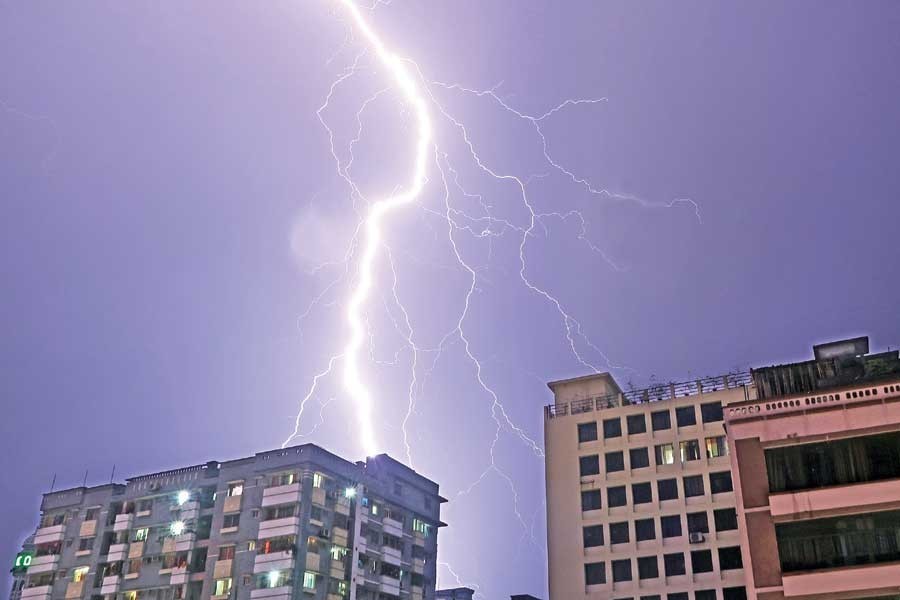
Published :
Updated :

Thunderstorms and thunderbolts are not uncommon in subtropical Bangladesh, especially, during the months of April and May in summer. But what is concerning is that in recent years the number of deaths and injuries from thunderbolts have been on the rise.
According to a study conducted under the department of environmental science of the Bangladesh Agricultural University (BAU), between 2010 and 2017, lightning strikes killed some 1986 people across Bangladesh. Interestingly, 32 per cent of the cases were reported in the month of May alone.
In May 2016, for instance, some 57 people reportedly died on two consecutive days by lightning strikes, a tragedy that prompted the government to declare thunderbolt a national disaster.
Since reports of deaths from lightning are too frequent and numerous, and seen as no more than something fortuitous, the general public think this must be a new meteorological phenomenon. Many with a scientific bent of mind also believe the increased incidence of thunderbolts has something to do with climate change.
In fact, the high incidence of thunderbolts is not a concern of Bangladesh alone. Reports of increased number of lightning strikes with attendant death and injury figures are also coming from across the globe. Countries like Uganda, DR Congo, Malawi, Swaziland and South Africa in Africa; Malaysia, the island of Borneo, Cambodia, Vietnam and Thailand in Southeast Asia; South Asian countries including Bangladesh and India; Latin American nations including Brazil, especially, the Amazon region have all reported an increase in the number of thunderstorms and deaths and injuries from those incidents. But what is the real cause behind this higher frequency of thunderbolts as being observed in recent times? What do climate scientists and atmospheric physicists say about it? Most climate scientists agree that we have been getting more reports of thunderstorms, thunderbolts and casualties related to them. True, rise in atmospheric temperature is directly linked to climate change. The Intergovernmental Panel on Climate Change (IPCC), the highest global authority on climate science, however, holds that global warming has a relation to an increase in the intensity, though not the number, of thunderstorms. However, increase in the intensity of thunderstorms means more lightnings. And for every one degree rise in global warming, the number of lightning will increase by 10 per cent. However, no such increase is visible according to IPCC's calculations for the period up until 2030.
Experts say, of over 100 lightnings that strike the earth every second, 70 per cent of those take place in the tropics and subtropics. So, people of these regions are more at risk of being struck by lightnings.
Some scientists are wont to ascribe the rise in thunderbolt-related casualties to more people now working outside than before. That is only natural, because world population has increased manifold in recent decades compared to what it was in the past. As more people are now working outside their homes, the probability of their getting hit by a thunderbolt has also increased proportionately. Moreover, with information explosion, we are now getting more reports on thunderbolt-related deaths and injuries than, say, a quarter century ago. And such reports are coming more from the developing and the least developed countries than the developed ones. This is for the simple reason that unlike in the developed world, poorer countries in the tropics and subtropics have fewer or no protection measures from thunderbolts for their populations. They have fewer or no lightning sensors and other related electronic devices and apps in place to warn people against impending thunderstorms or lightning strikes! And so, it is no wonder that Bangladesh, with its large population, is also facing such a higher intensity of thunderbolts and fatalities from them.
As such, to reduce lightning-related deaths and injuries, Bangladesh needs to have the protective measures including lightning sensors duly installed around its farms and fields where people work. At the same time, there should be counselling from the government's publicity wings through electronic media including mobile phones so people can know in advance about rain, thunderstorms, and attendant thunderbolts and also how to remain safe.


 For all latest news, follow The Financial Express Google News channel.
For all latest news, follow The Financial Express Google News channel.